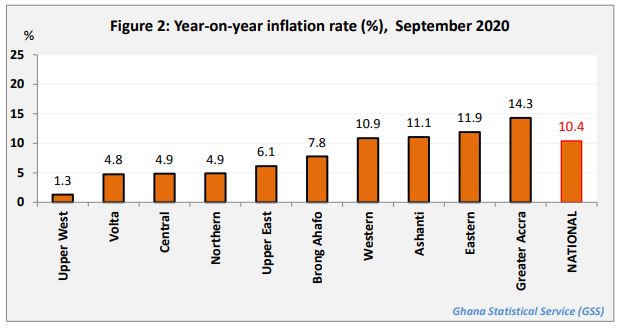Inflation drops lowest in the last six months to 10.4%
The rate of increase in the prices of goods and services across the country has dropped marginally to 10.4% for September 2020 due to food prices.
The Ghana Statistical Service announced on Wednesday that inflation for September dipped by 0.2% on account of the food basket of the Consumer Price Index (CPI).
“This means that in the month of September 2020 the general price level was 10.4 % higher than in September 2019,” Government Statistician, Prof. Samuel Kobina Annim, noted.
The food basket takes into consideration the prices of food items such as maize, vegetables and cassava; as well as non-food items which include clothing, water, and electricity.
The GSS takes an average of about 307 items in the basket which represents purchasing habit of the population. Prices are collected for approximately 39,500 products every month from 44 markets.
September’s rate was the lowest since panic purchases for COVID-19 pushed inflation to 10.6% in April.

Ghana recorded its first COVID-19 cases on March 12 and a lockdown was imposed late the same month spanning up to three weeks.
Purchases around that period scaled inflation beyond single to double digits and it has remained there ever since.
September’s figure is also 0.1 percentage points lower than that of August 2020.
Difference between locally produced items (12.3%) and imported items (5.1%) was 7.2%
Food and Non-food inflation for September 2020
The Food and Non-alcoholic beverages inflation rate recorded a year-on-year inflation rate for September is 11.2 per cent, 0.2% lower than 11.4% recorded for August 2020. Within Food subgroups, Vegetables (18.9%) recorded inflation rates higher than the group’s average rate of 13.7 per cent. Food contributed 47.6% to the total inflation and thus is still the predominant driver of year-on-year inflation.
The Non-Food group recorded a year-on-year inflation rate of 9.8 per cent in September 2020. The Non-Food inflation for September 2020 is 0.1 percentage point lower than the 9.9 per cent recorded for August 2020.
Regional differentials
At the regional level, the year-on-year inflation rate ranged from 1.3 per cent in the Upper West to 14.3 per cent in the Greater Accra Region. Ashanti (11.1%) and Western Region (10.9%) and Eastern (11.9%) recorded inflation rates above the national average of 10.4% Upper West had the lowest year-on-year inflation rate.

Inflation and MPR
The new inflation rate is still beyond the target band of government which is 8.0 ± 2 but will be welcoming for the government as it carries more expenditures on projects as the country heads to the polls in December 2020.
A dip is also an encouragement to the Bank of Ghana (BoG) which maintained its Monetary Police Rate for the third consecutive time after reduction to 14.5% on the account of the COVID-19 pandemic in March.
A reduction is aimed at increasing the circulation of money in the system to spur economic growth but accompanied by an undesirable tendency of high inflation.
But the Governor of the BoG, Dr Ernest Addison, said the central bank acknowledged “that risks to the immediate outlook for inflation and growth are broadly balanced” before rolling out the last MPR.
READ ALSO:
- Food Prices Pushes Inflation Beyond Single Digit
- Food Pushes August Inflation Down To 10.5%
- BoG Holds Policy Rate At 14.5% Third Time In A Row



